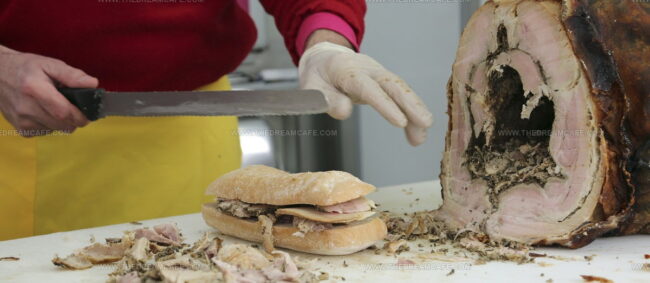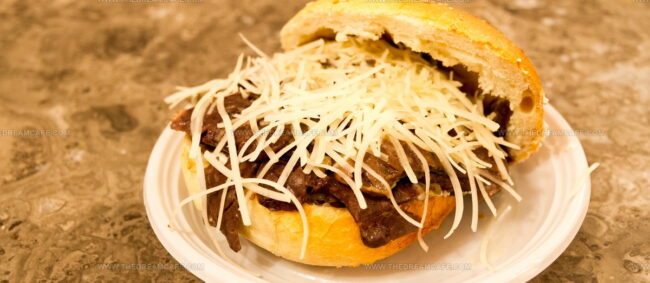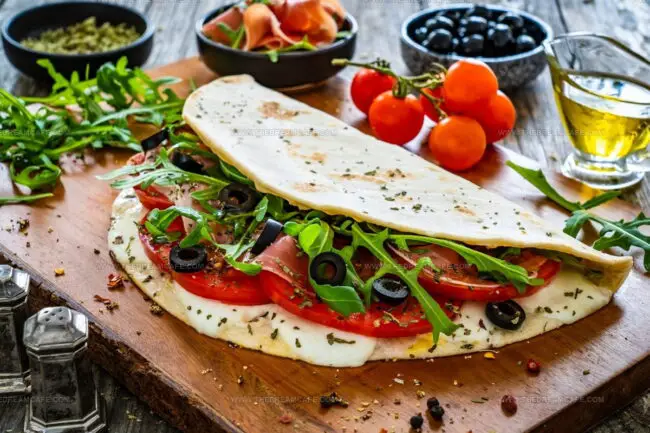25 Favorite Italian Sandwiches Wraps That Make Lunch Better
Italian sandwiches represent culinary masterpieces that capture the essence of Mediterranean flavor and creativity.
Bread becomes a canvas for vibrant ingredients bursting with regional character and passion.
These handheld delights showcase remarkable versatility and cultural depth.
Generations of Italian families have perfected sandwich-making techniques passed through generations with remarkable precision.
Regional ingredients transform simple bread into extraordinary gastronomic experiences that tantalize taste buds.
Each sandwich tells a unique story of local traditions and culinary innovation.
You can practically taste the sunshine and warmth infused in every carefully crafted bite.
The following list reveals 25 mouthwatering Italian sandwiches that will transport you directly to the streets of Italy:
Favorite Italian Sandwiches & Wraps to Try
Italian sandwiches and wraps, from panini to piadina, bring together cured meats, sharp cheeses, and fresh vegetables. Savor handheld classics that are perfect for any occasion.
Panino Col Polpo
Panino col polpo stands as a celebrated street food sandwich from Bari, southern Italy, featuring succulent grilled octopus nestled inside a soft bread roll.
Seafood lovers relish this simple yet flavorful dish prepared by slowly grilling fresh octopus over hot embers.
Fishermen and local vendors carefully brush the octopus with a fragrant mixture of olive oil, parsley, salt, and black pepper during cooking.
Street festivals in Apulia frequently showcase this classic sandwich as a popular snack.
Olive oil and herbs enhance the tender, smoky octopus meat before being tucked into a split bread roll.
Regional ingredients and traditional grilling techniques make this sandwich a genuine taste of Bari's coastal cuisine.
Mozzarella In Carrozza
Mozzarella in carrozza represents a classic Italian street food featuring crispy fried sandwiches stuffed with creamy mozzarella cheese.
Southern Italian regions popularized this simple yet irresistible dish made with crustless bread and fresh buffalo mozzarella.
Bakers typically use slightly stale bread to prevent soggy results during frying.
Cooks first layer mozzarella between bread slices and coat the sandwich in flour and beaten eggs.
Anchovies sometimes enhance the sandwich's flavor profile for savory variations.
Traditional preparation involves carefully dipping assembled sandwiches in flour mixture to prevent cheese leakage.
Frying transforms the sandwich into a golden-brown crispy exterior with molten cheese center.
Quick cooking ensures a crunchy texture while maintaining a soft, melted interior.
Porchetta Sandwich (Panino Con La Porchetta)
Panino con la porchetta represents a quintessential Italian sandwich celebrating slow-roasted pork with crispy skin nestled between fresh bread.
Central Italian regions like Umbria and Lazio compete for porchetta's origin, highlighting its cultural significance.
Romans and Italian-Americans particularly enjoy this simple yet flavorful sandwich.
Homemade bread provides the perfect foundation for absorbing the meat's rich herbal juices and fat.
Porchetta's intense seasoning eliminates the need for additional ingredients.
Traditional preparation involves keeping the crackling skin intact for maximum texture.
Minimal preparation and maximum flavor define this beloved street food.
Generations have savored this iconic sandwich as a testament to Italian culinary simplicity.
Panino Con Mortadella
Panino con mortadella represents a classic Italian street sandwich featuring creamy, smooth mortadella as its star ingredient.
Romans and Italians across regions love this simple yet flavorful handheld meal built on fresh bread like rosetta or pizza bianca.
Bakers carefully slice soft, bulbous rosetta rolls and layer them with premium mortadella slices.
Variations include adding soft cheeses, pickled vegetables, or tangy mustard spread to enhance the sandwich's rich flavor profile.
Quality ingredients make this sandwich shine, with high-grade mortadella from Bologna taking center stage.
Bread selection matters significantly, with traditional Italian bread styles providing the perfect texture and base.
Street vendors and small delis often prepare these sandwiches quickly for hungry customers.
Regional preferences influence subtle ingredient changes, making each panino con mortadella a unique culinary experience.
Tramezzino
Tramezzino is a delightful Italian triangular sandwich crafted from soft white bread without crusts, offering an elegant handheld meal packed with versatile ingredients.
Born in 1925 at Turin's Caffe Mulassano, this compact sandwich quickly became a beloved snack across Italy, particularly in Venice.
Venetians often pair tramezzini with a refreshing Spritz, creating a perfect mid-afternoon treat.
Typical fillings include creamy mayonnaise, tender tuna, salty prosciutto, and smooth cheese.
Sandwich makers create numerous flavor combinations to suit different tastes.
Cafes throughout Italy serve fresh tramezzini daily.
Supermarkets also sell pre-packaged versions for convenient snacking.
Panelle
Panelle are crispy Sicilian chickpea fritters originating from Arab culinary influences during their 9th to 11th-century island occupation.
Arab settlers brought these savory street food staples to Sicily, transforming local cuisine with their innovative recipes.
Palermo street vendors serve these golden-brown fritters in round sesame seed buns, creating a popular quick meal.
Chickpea flour forms the base of these light, crispy snacks that are quickly deep-fried until perfectly golden.
Warm panelle taste best when drizzled with fresh lemon juice, adding a bright citrus note to their rich flavor.
Some locals enhance the fritters by topping them with creamy fresh ricotta cheese for extra texture.
Street food enthusiasts often enjoy panelle as a quick, satisfying snack that reflects Sicily's diverse cultural history.
These fritters showcase how simple ingredients can create an incredibly flavorful and beloved regional specialty.
Puccia Pugliese
Puccia Pugliese are rustic sandwiches originating from Salento and Taranto that showcase southern Italian street food culture through their versatile round bread.
Regional bakers craft these 20-30 cm diameter breads using pizza or traditional dough with minimal crumb, perfect for substantial fillings.
Specialty versions like uliate incorporate cured black olives, while semolina variations offer additional texture and flavor.
Traditional fillings include local cured meats such as capocollo di Martina Franca and fresh giuncata cheese.
Vegetable-packed options provide lighter alternatives for health-conscious diners.
Generations of southern Italian families have enjoyed these portable, satisfying sandwiches as quick meals or street snacks.
Regional ingredients and simple preparation methods define the authentic puccia experience, connecting modern eaters with generations of culinary tradition.
Panuozzo Di Gragnano
Panuozzo di Gragnano are authentic Italian sandwiches born in Naples that transform pizza dough into a crispy, flavor-packed street food experience.
Giuseppe Mascolo invented this unique bread in 1983 in Gragnano, a small town near Naples where his family exclusively owns the trademark.
Wood-fired pizza ovens create the signature bread, which starts as traditional pizza dough baked whole and then sliced lengthwise.
Cooks carefully select premium ingredients to stuff inside the warm bread.
A second brief oven heating ensures a perfect crispy exterior and melds the filling with the soft interior.
Ingredients range from classic Italian meats and cheeses to creative vegetarian options.
Regional traditions inspire each sandwich's unique combination.
Family recipes and local ingredients define this beloved Neapolitan street food innovation.
Tramezzino Veneziano
Tramezzino Veneziano represents a delightful Venetian sandwich crafted with crustless white bread triangles filled with creamy mayonnaise-based ingredients.
Venetian bakeries first popularized these puffy, smile-shaped sandwiches as quick lunch options for busy workers.
Traditional fillings include classic combinations like tuna with hard-boiled eggs, ham with mushrooms, or mozzarella with tomatoes.
Regional humidity ensures the bread remains exceptionally soft and fresh.
Generations of Venetian families have enjoyed these compact sandwiches as convenient midday meals.
Modern variations now feature innovative ingredients like salmon and avocado.
Restaurants and cafes across Venice serve these sandwiches as popular street food.
Tramezzini continue to reflect the city's culinary creativity and love for simple, satisfying snacks.
Tramezzino Piemontese
Tramezzino Piemontese represents a delicate Italian sandwich crafted from soft triangular pancarre bread, pioneered by Angela De Michelis and her husband Onorino Nebiolo in 1926 at Turin's Caffe Mulassano.
Their innovative creation transformed traditional English tea sandwiches into a unique Italian culinary experience, initially featuring simple butter and anchovy fillings.
Modern tramezzini now boast an impressive variety of sophisticated ingredients, with top favorites including luxurious options like lobster, truffles, veal in tuna sauce, and bagna cauda.
Caffe Mulassano currently offers around 30 distinct tramezzini variations, showcasing the sandwich's remarkable evolution.
Crustless and untoasted, these triangular delights highlight quality ingredients and elegant presentation.
Regional Piedmontese influences shine through each carefully assembled bite.
Small yet complex, tramezzini demonstrate Italian creativity in sandwich making.
Lampredotto
Lampredotto is Florence's iconic street food delicacy crafted from a cow's fourth stomach, boiled tenderly in aromatic broth until perfectly soft.
Street vendors have prepared this traditional Tuscan dish for centuries as an affordable, protein-rich meal.
Locals love the sandwich version, which features sliced lampredotto nestled inside crusty bread rolls.
Butchers carefully clean and prepare the abomasum, ensuring a clean, appetizing texture.
Italian herb sauce called salsa verde adds a zesty complement to the rich meat.
Medieval Florentine workers originally embraced this filling street food as a nutritious lunch option.
Generations of Italians have passed down the unique preparation technique through family traditions.
Travelers seeking authentic Florentine cuisine often hunt for this distinctive street food experience.
Pani Ca Meusa
Pani ca' meusa, a beloved Sicilian street food from Palermo, delivers a bold culinary experience through its unique sandwich featuring fried calf spleen and sometimes lungs nestled in a soft vasteddabun.
Street vendors have sold this traditional dish for generations, reflecting Sicily's resourceful food culture.
Two primary versions exist: schettu, which highlights the meat's pure flavor with a simple lemon juice squeeze, and maritatu, enhanced with shredded caciocavallo cheese.
Butchers carefully prepare the spleen strips by deep-frying them in lard, creating a rich and intense flavor profile.
Locals and adventurous food enthusiasts seek out this sandwich as an authentic taste of Palermo's street food heritage.
Italian immigrants originally developed this dish as an affordable protein option using less-desired meat cuts.
Salt and pepper often complete the seasoning, adding subtle depth to the robust meat.
Sicily's gastronomic creativity shines through this straightforward yet memorable street food specialty.
Zingara Di Ischia
Zingara di Ischia is a mouthwatering grilled sandwich originating from Naples, Italy, featuring rustic peasant bread loaded with classic Mediterranean ingredients.
Crafted in 1970s Ischia Ponte, this street food staple combines crispy grilled bread with smooth fior di latte cheese and savory prosciutto crudo.
Ripe tomatoes and creamy mayonnaise add fresh layers of flavor to the sandwich's rich profile.
Regional cooks often enhance the traditional recipe with additional salad ingredients for extra texture and taste.
Neapolitan bread serves as the perfect foundation for this handheld meal.
Italian culinary traditions shine through in every bite of this simple yet satisfying creation.
Summer gatherings and beach picnics frequently feature this beloved sandwich.
Locals and tourists alike enjoy zingara di Ischia as a quick, delicious meal that represents southern Italian cuisine.
Panino Friulano
Panino Friulano represents a signature sandwich packed with regional Italian flavors from Friuli-Venezia Giulia.
Regional bakers craft this sandwich using soft homemade bread stuffed with premium prosciutto San Daniele and creamy Montasio cheese slices.
Local ingredients like fresh arugula and green pea cream enhance its robust flavor profile.
Regional bakers carefully layer each ingredient to maximize taste complexity.
Traditional preparation methods highlight quality local meats and cheeses.
Ingredients are selected from nearby farms and producers in northeastern Italy.
Mediterranean culinary techniques ensure balanced flavor combinations.
Fresh bread and premium protein make this sandwich a perfect quick meal.
Cuzzetiello
Cuzzetiello is a hearty Neapolitan sandwich crafted from the crusty end piece of pane cafone bread, traditionally stuffed with rich fillings like Neapolitan sausage and friarelli or homemade ragu with meatballs.
Naples street vendors originated this ingenious lunch break snack as a way to repurpose Sunday meal leftovers.
Workers loved its portable, filling nature and resourceful design.
Regional ingredients like eggplant parmigiana or beef stew frequently became sandwich stuffings.
Modern variations now include vegetarian options with roasted vegetables.
Sweet versions featuring Nutella have also emerged in recent years.
Young Neapolitans continue to enjoy this classic street food that connects them to traditional cooking methods.
Panin De Porzina Con Senape E Kren
Panin de porzina con senape e kren highlights Trieste's multicultural heritage through a compact street sandwich blending Austrian and Italian culinary traditions.
Rosetta bread cradles tender sliced pork roasted with aromatic herbs and spices.
Zesty mustard and sharp horseradish provide a pungent contrast to the succulent meat.
German and Slavic immigrants significantly influenced this regional specialty during Trieste's complex historical periods.
Careful seasoning and quality ingredients define the sandwich's authentic flavor profile.
Street vendors and small family-run shops typically prepare this quick, satisfying meal.
Regional ingredients sourced from local markets ensure maximum freshness.
Salt, pepper, and precise meat preparation elevate this simple yet powerful street food experience.
Pane Cunzato
Pane cunzato represents a rustic Sicilian street food masterpiece bursting with Mediterranean flavors and simple ingredients.
Sicilian bakers craft this sandwich using traditional rustic bread as its hearty foundation.
Extra virgin olive oil generously coats the bread, creating a rich base for layering fresh ingredients.
Ripe tomatoes add bright, juicy notes to the sandwich's profile.
Salt-cured anchovies contribute a robust, briny punch that elevates the entire dish.
Oregano sprinkles deliver an aromatic herbal touch that complements the other components.
Occasional cheese slices like caciocavallo or mozzarella provide creamy texture and additional depth.
This humble sandwich embodies Sicily's peasant food tradition of transforming basic ingredients into an extraordinary culinary experience.
Purgatorio Alla Calabrese
Purgatorio represents a fiery Calabrian street food sandwich bursting with rustic Mediterranean flavors.
Bakers hollow out a fresh bread loaf and fill it with a simmering vegetable medley of plum tomatoes, eggplants, young potatoes, and peppers.
Olive oil and fresh basil enhance the sauce's rich complexity.
Slow-cooking transforms the vegetables into a tender, mouthwatering mixture.
Calabrian cooks carefully slice the bread lengthwise and scoop out its center.
They pour the hot vegetable sauce inside the bread and close it tightly.
Slicing the stuffed loaf reveals a steaming, colorful interior that blends bread and sauce into one delicious meal.
5 E 5
5 e 5 represents a classic Livorno street sandwich featuring a crispy chickpea pancake nestled between crusty bread.
Originating in the 1930s, this iconic snack earned its name from customers ordering five bread pieces and five chickpea pancakes.
Locals traditionally prepare the sandwich using pane francese, a bread similar to ciabatta, and fill it with a golden farinata (chickpea pancake).
Seasoned with black pepper, the sandwich often includes grilled or pickled eggplants enhanced with garlic, chili peppers, and vinegar.
Livorno street vendors continue serving this simple yet flavorful sandwich, which combines traditional Tuscan ingredients into a quick, satisfying meal.
Street food culture celebrates this compact, portable lunch that reflects the region's culinary creativity.
Panonta
Panonta are mountainous Italian sandwiches massive enough to feed multiple workers with a single massive bread loaf sliced and generously brushed with bacon grease.
Shepherds and farmers in Abruzzo, Molise, and Lazio regions originally crafted these hearty meals as portable sustenance during long workdays.
Traditional ingredients include crispy bacon, spicy sausages, fresh peppers, fluffy frittata, sharp grated cheese, aromatic garlic, and chopped parsley.
Mountain workers designed these sandwiches for maximum energy and convenience, layering rich ingredients between thick bread slices.
Each panonta represents a complete meal packed with protein and flavor.
Regional variations depend on available ingredients and local preferences.
Rural Italian workers developed this practical meal to survive demanding physical labor.
These sandwiches emerged from practical necessity in challenging agricultural landscapes.
Panino Con Straccetti Di Cavallo
Panino con straccetti di cavallo spotlights horse meat's unique culinary tradition in Southern Italian cuisine.
Horse meat sandwiches represent a distinctive regional delicacy originating in Apulia and Sicily.
Thin, tender strips of meat get marinated with olive oil, garlic, and rosemary before quick high-heat cooking.
Rustic Italian rolls or ciabatta serve as the perfect base for these flavorful sandwiches.
Sautéed onions, fresh arugula, and grilled vegetables enhance the meat's slightly sweet and gamey profile.
Spicy sauces or mustard often add extra zest to the sandwich.
Diners appreciate the rich, savory combination of ingredients that celebrate Italian meat preparation techniques.
Mediterranean flavors shine through in this distinctive street food experience.
Panino Con Salsiccia E Cipolla
Panino con salsiccia e cipolla merges rustic Italian street food traditions with simple, robust flavors through a hearty sandwich featuring spicy grilled sausage nestled on crusty bread.
Regional Italian regions like Tuscany and Umbria celebrate this street food classic with locally sourced sausage and sweet caramelized onions.
Traditional preparation involves slowly sautéing onions until they transform into a rich, golden-brown accompaniment that complements the sausage's bold taste.
Balsamic vinegar or red wine often enhances the onions' natural sweetness during cooking.
Ciabatta or soft sandwich rolls serve as the ideal base for this satisfying meal.
Toasting the bread adds a crispy texture that contrasts with the tender sausage and silky onions.
Panonta Di Miranda
Panonta di Miranda emerges as a robust Italian sandwich from Molise, combining layers of rich pork sausage, crispy bacon, and vibrant red peppers within a homemade bread loaf.
Regional butchers carefully craft this high-calorie meal by nestling a golden fried omelette between hearty meat slices.
Local families pass down techniques for preparing this substantial sandwich through generations.
Miranda and Roccasciura towns claim deep culinary roots for this specialty.
Skilled artisans select premium local ingredients to construct each complex layer.
Bread serves as the critical foundation for this meaty creation.
Flavor intensity distinguishes this sandwich from standard Italian street food.
Mountain traditions inspire its rustic composition.
Panontella
Panontella is a classic Roman street food sandwich featuring crispy, flavor-packed meat skewers grilled to perfection.
Authentic preparation involves carefully cubing and threading pancetta and guanciale onto skewers with precise seasoning.
Salt and pepper enhance the rich, smoky meat's natural flavors during grilling.
Romans traditionally use casareccio bread as the ideal base for these savory meat skewers.
Locals enjoy panontella as a quick, satisfying snack that showcases the region's love for simple, high-quality ingredients.
Street vendors and small restaurants across Rome serve this unpretentious dish.
Meat selection and careful grilling technique determine the sandwich's overall quality.
Profezeni
Profezeni are robust Italian sandwiches from Trentino featuring unique organ meat fillings crafted with chopped veal brains as their central ingredient.
Bakers carefully select thick bread slices and soak them in milk before preparing the filling with butter-sauteed brain meat and fresh parsley.
Skilled local artisans layer the tender brain mixture between milk-soaked bread slices, creating a rustic sandwich with deep regional roots.
Olive oil enhances the cooking process while eggs and flour contribute to the sandwich's rich texture.
Traditional preparation involves precise cooking techniques that transform simple ingredients into a memorable regional specialty.
Each sandwich represents generations of northern Italian culinary innovation and resourcefulness.
Bread serves as the primary vessel for showcasing the delicate brain meat mixture.
Onions add subtle depth to the overall flavor profile of this distinctive sandwich.
What Ingredients Are Most Commonly Used in Italian Sandwich Fillings?
Italian sandwiches - known as panini or tramezzini depending on the style - feature a variety of fresh, flavorful ingredients that highlight regional specialties and simple quality:
Is Olive Oil Often Used Instead of Butter or Mayonnaise in Italian Sandwiches?
Yes, olive oil is a staple in Italian sandwiches and is frequently used in place of butter or mayonnaise. It serves multiple roles, starting as a flavor enhancer - extra virgin olive oil adds fruity, peppery notes that beautifully complement the meats, cheeses, and vegetables.
Additionally, a drizzle of olive oil helps bind ingredients together and keeps the bread from drying out, ensuring each bite is moist and flavorful.
Beyond taste and texture, olive oil is valued as a healthier alternative, offering heart-healthy fats preferred in Italian cuisine over heavier spreads like butter or mayo. It’s also commonly brushed on the outside of panini before grilling, creating a crisp, golden crust that’s both visually appealing and delicious.
This widespread use of olive oil reflects Italy’s Mediterranean culinary tradition, which emphasizes fresh, wholesome ingredients and simple yet vibrant flavors.
















